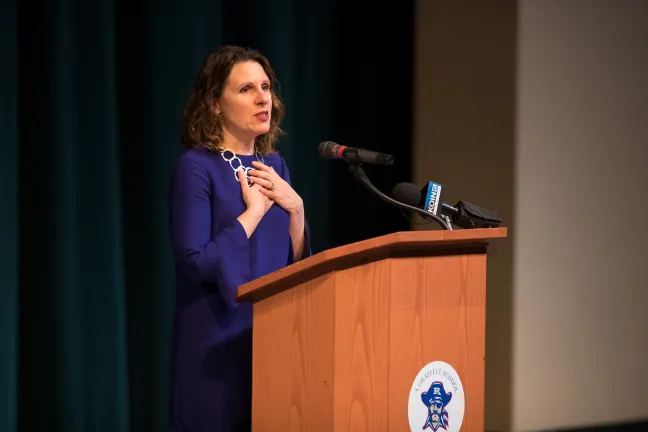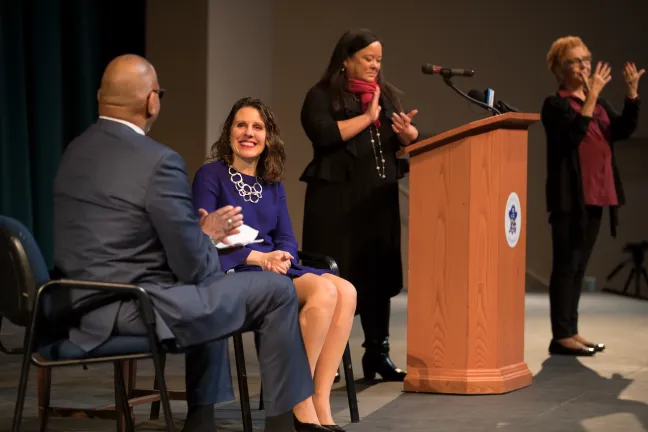Multnomah County Chair Deborah Kafoury, in the 2018 State of the County on Friday, announced new investments in affordable housing and new partnerships to expand the mental health and social services that keep people housed.
Kafoury gave her address at Reynolds High School where four years ago, on her first day as Chair, a student opened fire on classmates and teachers, killing 14-year-old Emilio Hoffman.
During that first day on the job, she sent crisis counselors to support parents reuniting with their kids, and in partnership with nonprofits and local agencies, opened a crisis center for community members. That night she attended a vigil and vowed to increase mental health services in schools. Since then, the county added mental health professionals and now serves 1,600 students in six school districts.
The State of the County is produced by the City Club of Portland. This year’s event included a discussion with Reynolds High school students and members of the Multnomah Youth Commission. It was moderated by Kevin Modica, former Portland Police Bureau assistant chief and legislative assistant for Sen. Lew Frederick.
Kafoury spoke to an auditorium of more than 400 people, including Portland Mayor Ted Wheeler, Gresham Mayor Shane Bemis, Fairview Mayor Ted Tosterud, Troutdale Mayor Casey Ryan, and Wood Village Mayor Timothy Clark.
It’s the first time the county has held its annual address outside Portland’s city center, underscoring a closer partnership with the county’s smaller eastern towns, including major road improvement projects and new student health services.
They are the communities that welcome low-income families pushed out of Portland's housing market, farther from public transportation and social services. They are communities of color and immigrant communities.
They represent the dichotomy of a region in the midst of an economic boom.
Government can’t solve this crisis alone
“Driving to work, I’m always struck by the construction cranes dotting the skyline. You can literally feel Portland booming,” Kafoury said. “And yet, thousands of people are being left out.”
In fact, one-in-three families doesn’t make enough to cover their basic needs, and decades of federal disinvestment in affordable housing have left local governments to fill a widening void.
The City of Portland and Multnomah County have invested $100 million in affordable housing during the past two years, while the Joint Office of Homeless Services has worked to help families access basic shelter and move into more stable housing. Then last month, the state legislature earmarked $5 million to support basic shelter and housing for families across Oregon. $2.4 of that will serve residents of Multnomah County.
And still, the region needs new models of investment for supportive housing.
This year, the county will establish a Supportive Housing Investment fund, using revenue from local tourism taxes to pay for rent assistance and supportive services, arming outreach workers with resources to can get people into stable housing.
“I often say, government can’t solve this crisis alone,” Kafoury said. “We work with our partners to find new, creative solutions. And no one deserves thanks more than Bobby Weinstock.”
Weinstock works for Northwest Pilot Project. He proposed a local housing voucher program for low-income seniors to compensate for a Congress that cut funding for the federal Section 8 voucher program.
Sharon Newell, an older woman with Multiple Sclerosis, was one of the first recipients of the local voucher program. Her social security check wasn’t enough to cover the cost of an apartment, but the local voucher allowed her to secure an apartment for herself and her beloved dog Gracie.
The voucher program, she announced, has recently gotten an important boost: Meyer Memorial Trust has just committed $150,000 to explore how to expand a pilot project offering locally-funded rent vouchers to seniors.
Between life and death
Last year, Multnomah County’s 24-hour crisis response network fielded more than 80,000 contacts through the call center, mobile outreach and urgent care clinic. It has worked with teachers to improve outreach and prevention efforts in schools, and county staff offer free mental health first aid classes to help residents determine how to safely help during a crisis.
“With all that we’re doing, it’s so important to know what’s working,” Kafoury said. Commissioner Sharon Meieran, an emergency room doctor who often speaks about the resources available for people in crisis, spearheaded an analysis of the region’s mental health and addiction system. She’s also led the charge against pharmaceutical companies that used misleading marketing to saturate communities with addictive opioid painkillers.
In 2015, health professionals in the tri-county region wrote nearly as many as many opioid prescriptions as there are people in the region, according to an analysis by the Oregon Health Authority. That’s thanks in part to a multi-million dollar marketing campaign launched by Purdue Pharma, maker of OxyContin. The county filed a lawsuit against the company last August.
“When corporations recklessly promote a highly addictive product that destroys lives, we need to hold them accountable,” Kafoury said.
Meanwhile, county health officials have been working to mitigate the damage. County clinics adjusted their use of opioids to treat pain while Tri-County Health Officer Dr. Paul Lewis, brought together Kaiser, OHSU, Providence, Legacy, Adventist and insurance companies to commit to new prescribing guidelines.
Multnomah County also led the legislative effort to make the life-saving drug Naloxone available to the public. Since 2013, the Health Department and Outside In have distributed more than 10,000 doses through the syringe exchange program. Since then, at least 2,536 people have been rescued by Naloxone in Multnomah County.
“That moment, between life and death, changes everything. It literally opens a door to help,” Kafoury said Friday. “People are often ready to enter treatment, to talk to a peer in recovery, to believe their life is worth fighting for.”
Next month the county will partner with Lines for Life and convene an April 13 summit — bringing together the commissioners, sheriffs and district attorneys from Multnomah, Clackamas and Washington counties, to hammer out solutions, such as creating a central database of open treatment beds to quickly place people who are ready to quit.
Three-quarters of a billion dollars
In the past four years, even as state and federal infrastructure suffers from a lack of investment, the county has invested in building. The county erected a courthouse in Rockwood and a new Sellwood bridge, and has begun a $18-22 million maintenance project to reinforce the 93-year-old Burnside Bridge. Two major construction projects are well underway: a new county courthouse and Health Department Headquarters.
In east Multnomah County major road projects are repaving and widening streets and expanding pedestrian and bikeways, in Fairview, Troutdale and Wood Village.
“Together all these capital projects represent more than three-quarters of a billion dollars in new infrastructure,” Kafoury said. “But along the way, we put workers at the center of our efforts because projects are also a pathway to a long-lasting career in the building trades.”
Each project included goals to invest in women- and minority-owned businesses, and hire a workforce that reflected the region’s diversity. The county partnered with Construction Apprenticeship and Workforce Solutions to grow pre-apprenticeship training programs and connected the entry-level workers directly with contractors.
Echo Dahl, a single mother who lost her job during the Great Recession. She found the pre-apprenticeship program at Oregon Tradeswomen, and through that program, landed a job. Last November she attended a County Courthouse Hiring event where she connected with General Sheet Metal, and landed an even better job.
She nearly doubled her salary and bought a house.
The county is now partnering with Constructing Hope, Oregon Tradeswomen, and Portland Youthbuilders to create similar opportunities for 120 people of color and women
The Board of County Commissioners this week voted to set aside one percent of county construction funding for a Construction Diversity and Equity Fund to support development of pre-apprenticeship and workforce retention programs for low-income workers, women and people of color.
The foundation of this work was laid by Commissioner Loretta Smith, Kafoury said, who spearheaded the youth jobs program, SummerWorks.
We find solutions
Kafoury said she was proud to address a room filled not only with community members, but also with county staff, many who work quietly, often with little recognition.
They are employees like Daniela Schlechter-Keenan, a physician assistant at the county’s North Portland Health Clinic who came to the United States as a child for a series of life saving surgeries that continued into her 30s.
In January, Daniela was named one of Portland’s best healthcare providers in a survey of her peers by Portland Monthly Magazine.
“She sees entire families to make the most of appointments, she delivers groceries, and she advocates tirelessly for them,” Kafoury said. That advocacy prompted the Oregon Health and Science University to reverse an antiquated policy that excluded undocumented immigrants from being included on transplant lists.
Today, a mother of four is on that list, awaiting a liver transplant, because of Daniela and her Multnomah County team.
“I know that nationally, things feel deeply troubling, like we are coming apart,” she said. “But in Multnomah County, we’re better than that. We value each other’s perspectives. We listen to different points of view and we find solutions.”
Find out more
Read the
Watch the 2017 State of the County
Watch the 2016 State of the County
Watch the 2015 State of the County
Watch the 2014 State of the County


